This website is supported by its readers. If you click one of my links I may earn a commission. I am also a participant in the Amazon affiliates program and I will also earn a commission from qualified purchases.
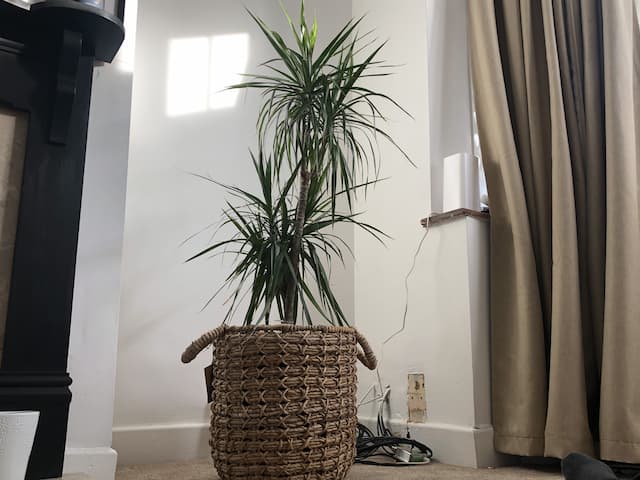
Dracaena plants are prevalent worldwide because they’re easy to grow and maintain. However, they still face their fair share of problems. These plants can go through many issues in their lifetime, like discoloration. So, why do dracaena have brown spots?
The most common reason that dracaena have brown spots is inconsistent watering and underwatering. Watering dracena infrequently will cause the soil to dry out, causing brown spots on the leaves and tips.
To prevent this, ensure you water your dracaena once every 10 to 14 days or thrice per month.
So how can you prevent brown spots in your dracaena? Keep reading to find out more!
Just a quick heads up, over the past three years of running Plantpaladin, hundreds of people have asked for product recommendations. As such, You can find my favorite indoor bonsai tree here (link takes you to Bonsaiboy), my favorite outdoor bonsai tree (link takes you to Bonsaiboy), or have a look at all the products I recommend here.
Why Do Dracaena Have Brown Spots?
So I started noticing brown spots on a few of my dracaena a few weeks back.
Now having had my dracena for around two years or so now, I was a little surprised.
As far as I knew, I hadn’t changed the care of my dracena.
Having kept bonsai, too, I was familiar with growing plants indoors, so as you can imagine, I was a little unsure as to why the brown spots were occurring.
To get to the bottom of this, however, I got in touch with my local botanical gardens and undertook a quick survey of ten plant paladin readers.
To summarize:
- The most common reason for dracaena having brown spots is inconsistent watering.
- Dracaena should be watered once every 10 to 14 days, so watering on a schedule or too inconstantly will cause these brown spots to appear.
- Other significant causes of brown spots on dracena include too much fluoride in your potting soil. If this is the case, consider using rain or filtered water to reduce the fluoride in your plant.
- Finally and most seriously, brown spots on dracena could be caused by leaf spot disease/fungus, which will need to be remedied by using an antifungal spray or fungicide on your plant.
- Other brown spots lack light, saturation, and heat quality.
Let’s explore these in more detail.
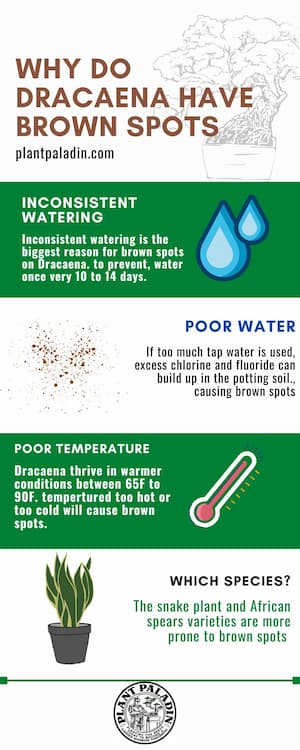
What Are Dracaena Plants?
Dracaena is a genus of plants that contain quite a few different species. The main two types are the treelike variety and rhizomatous plants.
While each one has specific characteristics, they share some common ground. Both have tropical spear-like leaves and are usually a bright green shade.
A few reasons can cause the leaves to change color or shape. However, before you can do anything about it, you have to identify the problem.
Why Do Dracaena Have Brown Spots?
One of the most common issues with dracaena is brown spots appearing. The exact shape and dimension of the patches can vary depending on what caused the problem.
Besides that, the age of each leaf can also affect the formation of the spots. Here are some of the reasons:
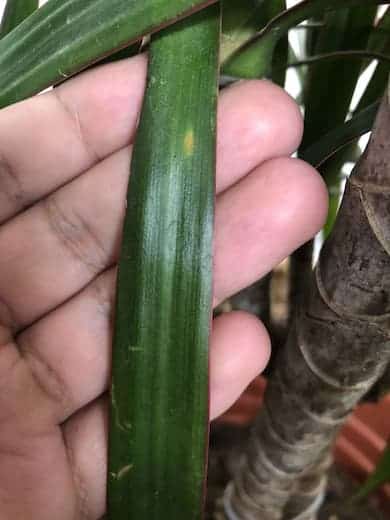
Watering
Whenever a plant is going through issues, generally, water is the main culprit. That’s because every species requires a specific amount of hydration to function.
So, the slightest increase or decrease can have adverse effects on dracaena.
Water Amount
Dracaena, like most plants, absorb liquids through their roots. They use water to maintain their shape and stay upright. That allows them to direct the leaves to the sun and gather sunlight for nutrition.
On top of that, these plants need water to transport nutrients. Most of the minerals dracaena rely on are water-soluble.
Without the water, the plants will dry out and be unable to move food around. That’s why the plants will start to discolor.
Usually, the edges of the leaves will turn brown and a little crisp. If the problem persists, the spots can spread out and even appear in random places.
Unfortunately, a similar process occurs when you over-water the plant. The roots inside the soil may start to rot and fail to absorb water or minerals.
It’s crucial to water the plants consistently and on time.
Water Characteristics
The amount of liquid isn’t the only factor that affects the watering cycle. Water quality will also play a significant role.
Most of us hydrate our houseplants with tap water. While this is fine in most cases, sometimes it isn’t suitable.
For example, there are many homes all over the world with hard water running through their pipes.
That means it contains substances that may harm you and the plants. Using the water once or twice shouldn’t be an issue, but the salts can pile up over time.
The salts will eventually affect the quality of the soil and prevent the plant from growing. When we don’t address this problem, brown spots can form on the leaves.
Environmental Temperature
The temperature of the area where your dracaena live will also affect their health. These plants prefer an average temperature of about 65 to 90°F.
Below that, the leaves can become incredibly rigid and fragile. It’ll also affect the plants’ circulation.
When humans get cold, our fingers turn a whitish blue, and we can’t bend them easily. That’s because blood can no longer flow freely to our extremities.
The exact process happens with plants, but the medium is water instead of blood.
In that case, the areas of the plants not getting circulation can turn brown and dry up.
You also want to avoid placing dracaena in an overly warm area. Warm areas may cause the leaves to sweat and wilt, leading to a decline in overall health.
Light Saturation
As we all know, plants need the sun to survive. They need to absorb light through chlorophyll to produce energy and food.
For the plant to stay healthy, this needs to happen regularly. So, if the dracaena grows in the shade, it may need more energy to grow.
That’s when the leaves may turn brown and wilt.
However, too much sun is also a problem. The leaves are at risk because the sun can harm our skin with prolonged exposure.
The light can degrade the leaves and break them down on a cellular level. When that happens, the plants will quickly turn brown.
You’ll notice that the discoloration spreads from the outside toward the middle in a couple of days.
If your dracaena severely lacks light, I strongly recommend investing in artificial light.
Air Quality
Dracaena can be sensitive to pollutants in the air. The source of this contamination can be industrial or chemical. It can even be excess cigarette smoke.
These pollutants may affect the plant’s ability to absorb oxygen.
In this scenario, the plants will slowly wilt and discolor. The change in color starts very subtly, then as the plant fades, the leaves will grow brown spots.
Usually, the pollution has to be pretty severe to affect dracaena. This only happens if dracaena never gets fresh air.
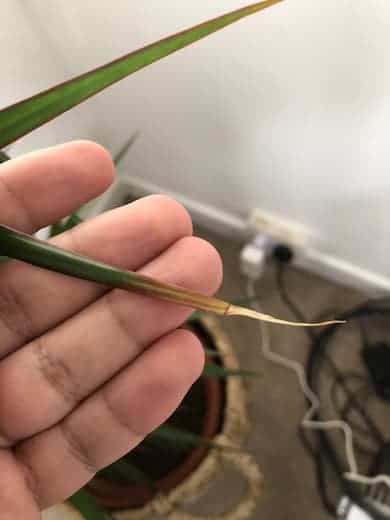
Humidity Levels
Pollution isn’t the only element in the air that causes browning. The surrounding humidity level will have apparent effects on the plants.
In dry environments, dracaena leaves will begin to sweat. This is because they try to humidify the space to reduce heat damage and stay rigid.
The plants will keep doing this until they use up all the water in their soil. As we discussed before, this will lead to wilting.
Soil Fertilization
Besides water, the soil has to contain nutrients to support healthy dracaena growth. Some of these include:
Each of these will work hand-in-hand to keep the plants in excellent condition.
While these should naturally occur in most soils, that’s not always the case. Some soil is barren and can’t support plant growth.
In that scenario, you’ll need fertilizer. For dracaena, choose one with a 3:1:2 ratio. That means it’s three parts nitrogen, one part phosphorus, and two parts potassium.
Together, these should be able to bring your plants back to life.
Soil Aeration
Most people with houseplants tend to focus on the visible portion of the flora. They can forget that half of the plants live underground.
They don’t realize that roots need oxygen just as much as the leaves. So, the roots can fade if the soil is too compact or has been stagnant for a while.
After that, it won’t take long for the rest of the plants to dry up and fall apart. That’s why it’s best to agitate the soil every few weeks.
This will allow air and oxygen to circulate through the ground and reach the roots.
Infestations and Infections
Sometimes, the reason behind the dracaena developing brown spots isn’t internal. There are external forces that may cause discoloration.
For starters, pests have a long history of ruining plants. Since dracaena produce their sugar, they attract critters like scales and mealybugs.
These insects will attack the stems and other fleshy parts of the plants. They may also start nibbling on the leaves.
When that happens, dracaena won’t be able to sustain their growth, and they’ll lose their leaves.
A similar process occurs with infections. When microorganisms land on plants or soil, they feed on it from the inside out. Over time, this will lead to damage, and eventually, the dracaena will fade.
For example, spot disease is a fungal infection that causes brown spots all over the plant.
How to Treat Brown Spots on Dracaena?
Now that you have a little background on the cause of the brown spots, we can move on to treatment plans.
Here’s everything you’ll need to do to get your dracaena back into tip-top shape:
Step 1: Identify the Problem
Start by giving the plants a thorough examination.
Look for any signs of the issues we discussed. Check the soil and environments for any contaminants.
Step 2: Prune the Plants
After you identify the issue, you have to prune the dracaena. This will involve removing all the leaves or stems that have traces of brown spots.
Cutting out dead or dry leaves is also a good idea. Yet, it would help if you were careful not to damage any healthy parts.
Take your time with this step and ensure you remove all the damage.
Step 3: Eliminate the Issue
Depending on the cause of the problem, this step will be a little different. However, there’s a general solution if you can’t put your finger on the issue.
Begin by repotting the plant. Gently remove it from its container, and place it in fresh soil. While you do this, ensure that the roots are intact.
This is also an excellent opportunity to clean out the surface of the dracaena. Look for any signs of pests or infections and remove them.
Don’t forget to go through the roots and cut out any dead parts.
Step 4: Replenish the Plants
Once you place the dracaena in a new pot, you must replenish its resources. The first part of this is replacing the nutrients.
To do that, sprinkle a couple of teaspoons of fertilizer on the surface of the soil. Then, it’s time to add a little water.
The plants will need around two cups of water every week. As a rule of thumb, you want the soil damp but not wet.
Step 5: Find a New Resting Place
Finding a new spot for your plants is the next step if the air quality and humidity are the issues. Find an area with indirect sunlight that gets a steady breeze.
After this step, your dracaena should start to get better. However, this process will take some time.
It can take up to a few weeks for your plants to return to normal.

What Species of Dracaena Are More Susceptible to Brown Spots?
With hundreds of species in the family, some are more susceptible to brown spots than others. Typically, rhizomatous dracaena face more issues than the treelike variety.
That includes flora like the Snake plant and the African spear.
Even though it’s less likely, treelike dracaena can still go through all the issues we discussed.
How to Prevent Getting Brown Spots on Your Dracaena in the Future?
Preventing brown spots can be a little tricky. There are no rules aside from ensuring the plants have all their basic needs met.
However, you can reduce the chances of infestations and infections. To do that, fill a spray bottle with water and a few drops of soap.
Mist your dracaena with the solution once every couple of weeks. The soap should repel any pests that may be present.
Are White Spots on Dracaena the Same as Brown Spots?
White spots on dracaena are rare, but they can happen with mealybugs. As these pests nest and grow, they appear as if they’re bright patches on the plants.
The only way to get rid of them is to remove them physically. You can do that with a blunt knife and a little patience.
Gently scrape the white spots until they lift off. If there are too many, you can use a slow stream of water to go through the process manually.
Doing this manually will take a while, but it’ll be more accessible than removing the critters.
Be sure that you remove all traces of the pests. Just one mealybug can restart the entire infestation.
Survey results
So I didn’t want to rely on my dracena plants but get a broader opinion on why dracaena have brown spots.
I asked ten plant paladin readers why they think their dracaena have brown spots.
To summarise:
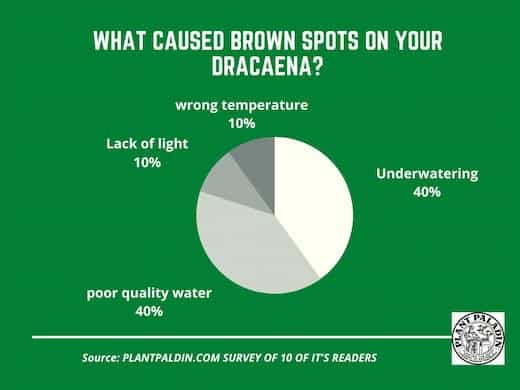
Wrapping Up
Why do dracaena have brown spots? There are a few reasons this could happen. Usually, the issue is with the watering of the plants.
Still, environmental factors like temperature, humidity, and air quality can cause this. Sunlight and soil composition will also play a significant role.
Other than that, infections and infestations may cause brown leaf spots.
After identifying and dealing with the culprit, repot your plants to grow them back better than ever.
My top picks for the gear you will need!
So like I mentioned earlier, over the past three years of running PlantPaladin, hundreds of people have asked me for my recommendations on the best bonsai gear on the market.
Having spent thousands of dollars on bonsai items these past few years and tested at least 100 bonsai-specific products, I’ve listed my favorite products below – All of which I highly recommend and think you can get great value.
They can purchase directly by clicking the link to take them to Amazon.
Bonsai Tool Set: One of the significant challenges I’ve had is finding a toolset that was not only durable but didn’t break the bank. SOLIGT has recently developed a fantastic bonsai tool set that covers all the tools you need to trim, prune, and repot your trees. – You can grab it here.
Complete Bonsai Set: Many of you will want to grow your bonsai trees entirely from scratch, but finding the varicose seeds, pots, and other items in one place can be challenging. Leaves and Sole then have created a complete bonsai set that I’ve personally used that ticks all the boxes. You can grab it here.
Bonsai wire: The number of times I’ve run out of wire for my bonsai or purchased cheap bonsai wire that doesn’t do the job is embarrassing for me to admit. After a lot of trial and error, I found that using Hotop’s aluminum bonsai wire is one of the best options on the market. This can easily be used for both indoor and outdoor bonsai. You can grab it here.
This post was written by Fehed Nicass, who has been passionate about bonsai for over 3 years. He currently resides in the UK and works in sales.
